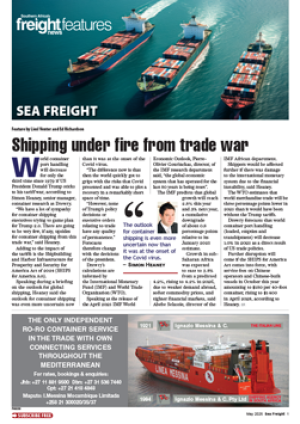ALAN PEAT
THE CHANGES to the Merchandise Marks Act of 1941 published in the Government Gazette, and applicable from May 23 could raise some tricky problems, according to David Watts of the SA Association of Freight Forwarders' (SAAFF) executive in KwaZulu Natal.
Not that the association has any objections to the principle of the amended marking system for imported clothing and textiles, he told FTW.
“The association fully supports the requirement for textile, clothing and allied products to bear correct country of origin marks at importation and the point of resale,” Watts said.
“But certain conditions as specified in the gazette notice will be difficult, and - in some cases - impossible to comply with.”
The result has been a letter to the Pretoria head office of the department of trade and industry (dti) seeking clarification of the various issues.
One example relates to Clause a) ii) – which states “there shall be applied……… the registration number of the importer”.
The practicalities of this requirement at the point of production will be either impossible or require substantial additional processing and cost, according to SAAFF.
“The production process of long runs of material or clothing enables a standard origin mark to be applied to each product or cloth length,” said Watts. “This will invariably read “Made in etc.”
“For a production run to require that the additional information specific to one order and one client be applied at the same time will involve either far shorter runs or the withdrawal of the relevant product - and individual items being subjected to the application of SA importers’ codes.”
The problem here, Watts added, is that producers may not know who the ultimate customer is – and, therefore, have no knowledge of the country of destination, let alone the importer’s name and code.
The association also pointed to packed or “kimbled” goods – which would need to be unpacked and code numbers applied.
“This,” said Watts, “is a major task that would not only add material cost but also affect the product quality.
“To apply such a requirement in the footwear industry would in most instances be completely impractical as origin marks are usually applied whilst shoes are being assembled.”
It is also common practice for importers to purchase from sources other than the actual manufacturer.
“Once again,” said Watts, “we have a situation where there is no possibility of applying the importer’s code at the time of production.
The association believes that for imported goods a simple “Made in ……” mark should be the sole requirement.
The revised marking regulations could also cause trouble for the likes of the automotive industry, according to Watts.
“Fabrics can be supplied in specific boxes or beams designed to go directly to the assembly plants,” he says.
The placing of origin or other marks on the actual fabric will cause production difficulties.
New labelling rules pose practical and cost concerns
13 May 2005 - by Staff reporter
0 Comments
FTW - 13 May 05
13 May 2005
13 May 2005
13 May 2005
13 May 2005
13 May 2005
13 May 2005
13 May 2005
13 May 2005
13 May 2005
13 May 2005
Border Beat
Featured Jobs
New
New
